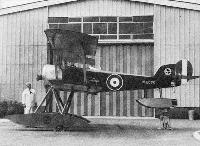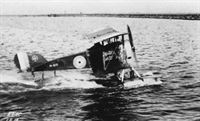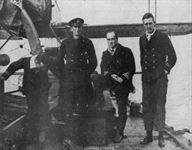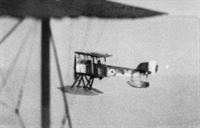
Описание
Страна : Великобритания
Год : 1914
Одноместный поплавковый разведчик
Sopwith Tabloid, Schneider и Baby
<...>Затем Томас Сопвич санкционировал переделку Tabloid в гидросамолет для участия во вторых состязаниях на кубок Шнейдера. Первые испытания с использованием однопоплавкового шасси начались 1 апреля 1914, пилотом был Говард Пикстон. Машина перевернулась и затонула, но ее успели поднять и доработать к началу состязаний. 20 апреля Г. Пикстон на Tabloid выиграл гонку, проводившуюся в том же году в Монако. Затем машину снова переделали в сухопутный вариант, но она была потеряна в катастрофе 27 июня.
<...>
Также была построена серия из 136 гидросамолетов-разведчиков Schneider, близких по конструкции к Tabloid, выигравшему Кубок Шнейдера. Летавшие с гидроавианосцев ВМС, они на протяжении 1915 года использовались для перехвата германских дирижаблей над Северным морем, правда, без особого успеха. Самолеты Schneider несли службу также на Средиземном и Красном морях.
На базе биплана Schneider был спроектирован более совершенный самолет Baby; для авиации ВМС в 1915-1916 годах было построено 286 машин, 100 компанией "Sopwith", а остальные - "Blackburn".
Baby был оснащен более мощным ПД Clerget, развивавшим 110 л.с. (82 кВт) или 130 л.с. (97 кВт). С последней силовой установкой Baby развивал максимальную скорость 161 км/ч на уровне моря и мог находиться в воздухе 2 ч 15 мин.
Самолет Baby мог быть вооружен одним синхронизированным пулеметом Lewis и нести до 29 кг бомб. Он использовался в качестве морского разведчика и бомбардировщика на Северном море, в Средиземноморье и в Палестине. Действовал самолет с береговых баз, а также с гидроавиатранспорта "Бен-май-Шри". Также машину использовали для противолодочного патрулирования.
ТАКТИКО-ТЕХНИЧЕСКИЕ ХАРАКТЕРИСТИКИ
Sopwith Schneider
Тип: одноместный поплавковый разведчик
Силовая установка: один 9-цилиндровый ротативный ПД Gnome Monosoupape мощностью 100 л. с. (75 кВт)
Летные характеристики: максимальная скорость 140 км/ч; время набора высоты 1981 м - 15 мин; потолок 2134 м; дальность полета 507 км
Масса: пустого 553 кг; снаряженного 771 кг
Размеры: размах крыла 7,82 м; длина 6,96 м; высота 3,05 м; площадь крыла 22,30 м2
Вооружение: один 7,7-мм пулемет Lewis и одна 30-кг или до пяти 9-кг бомб
- Описание
Фотографии
-
Мировая Авиация 239
На этом Tabloid Говард Пикстон выиграл гонку Шнейдера 1914 года, продемонстрировав среднюю скорость 139,66 км/ч. Он поддерживал высокую скорость на протяжении двух часов, превзойдя результат 1913 года на 40 км/ч.
-
Flight 1929-09 / Flight
Говард Пикстон сидит на одном из двух поплавков своего гоночного Tabloid. Самолет был самым маленьким и маломощным из участников Кубка Шнейдера в 1914 году. Но он оказался скоростным, маневренным и приятным в управлении.
Sopwith Sea Scout (100 h.p. Gnome Engine). Average Speed 86.8 m.p.h. Winner at Monaco 1914.
The 1914 Schneider Cup race at Monaco in April 1914 - the Tabloid floatplane. -
Aviation Historian 8 / R.Tisdale, A.Vercamer - Before & After
Surely one of the most evocative images of the glamour and romance of early aviation, the Sopwith Hydro-Seaplane bobs in the warm waters of the Mediterranean at Monaco in April 1914. The aircraft streaked into first place, despite its Monosoupape engine running on only eight of its nine cylinders for the last 13 laps of the race.
-
Мировая Авиация 62
Победа Пикстона в гонках на Кубок Шнейдера. 20 апреля 1914г.: Франция, выигравшая за год до этого соревнования, вторично проводила гонки на Кубок Шнейдера в Монако. Гонки выиграл австралиец Ховард Пикстон (на правом снимке его поздравляет Жак Шнейдер), прошедший дистанцию со средней скоростью 139,66 км/ч. Гидросамолет Sopwith Tabloid (левый снимок, в Монако) оснастили ротативным двигателем Gnome Monosoupap мощностью 100 л. с. В соревновании также участвовали два французских самолета Nieuport и швейцарский аэроплан FBA. У Пикстона на 15-м круге возникли неполадки в системе зажигания, но он первым пролетел требуемые 28 кругов, затратив вдвое меньше времени, чем лучший из французских участников, и по своей итоговой средней скорости побил предыдущий рекорд Мориса Прево, превысив его на 40 км/ч.
-
Flight 1925-11 / Flight
One of the two competing machines in the 1914 Schneider Cup Contest: Mr. Howard Pixton's winning Sopwith seaplane, 100 h.p. Mono-Gnome
-
Flight 1925-11 / Flight
THE SECOND SCHNEIDER CUP CONTEST, 1914: A fine view of the only two machines to complete the course; the Sopwith, piloted by Howard Pixton, who won the contest, passing the F.B.A. (Switzerland) flying-boat, piloted by M. Burri. Pixton's speed was 139-7 k.p.h. (86-8 m.p.h.).
Другие самолёты на фотографии: FBA Type A/B/C - Франция - 1913
-
Flight 1929-09 / Flight
THE SOPWITH BIPLANE, PILOTED BY HOWARD PIXTON, WINNING THE SECOND SCHNEIDER TROPHY CONTEST FOR GREAT BRITAIN. HIS AVERAGE SPEED FOR THE COURSE WAS 86-6 M.P.H.
-
Aviation Historian 8 / R.Tisdale, A.Vercamer - Before & After
Harold Barnwell beside the Schneider Trophy winner after its conversion to landplane configuration. Barnwell flew the aircraft as "21” for the race at the Aerial Derby at Hendon on May 23, 1914. Unfortunately, mist and fog ensured that only four of the 11 starters completed the course, Barnwell being one of those who was forced to drop out.
-
Aeroplane Monthly 1984-07 / R.Baxter - The Sopwith interview (1)
R. H. Barnwell rounds a pylon at Hendon in June 1914 during an event in the Third Aerial Derby. The Sopwith 3-Seater can be seen in the foreground.
Другие самолёты на фотографии: Sopwith Three-Seater - Великобритания - 1913
-
Мировая Авиация 239
Самолеты Schneider (на снимке) и Tabloid имели капот с характерными плоскими боковыми панелями. Schneider был очень близок по конструкции к гоночному Tabloid, сохранив среди прочего и хвостовой поплавок последнего.
-
Мировая Авиация 239
Установленный на Baby двигатель Clerget был закрыт капотом подковообразной формы. Самолет использовался для решения ряда военных задач.
-
Flight 1921-04 / Flight
Schneider Cup Baby Sopwith seaplane, No. 2103, now in the service of the Chilian Government at Talcahuana
-
Aeroplane Monthly 1978-03 / Personal album
Регистрационный номер: N2071 A fine study of one of the 186 Sopwith Baby seaplanes built in the Olympia Works of the Blackburn Aeroplane and Motor Co Ltd, at Leeds, as "Blackburn Baby seaplanes". Note the manufacturer's distinctive trademark on the fin. This example. N2071, seen at Great Yarmouth, had a 130 h.p. Clerget rotary up front. Of particular interest are the chequered cowling and “lucky black cat” emblem just visible forward of the serial number. A 65lb bomb is slung beneath the fuselage, and the aircraft is provided with both a synchronised Lewis gun on the fuselage and a second, angled Lewis fitted in the centre section.
-
Aeroplane Monthly 1981-12 / E.Ackery - Tales of an Indifferent Naval pilot (2)
DAVID OLIVER'S plate shows Leisure Sport's Sopwith Baby on the water at Thorpe Park recently.
-
Air Enthusiast 1971-07 / Veteran & vintage
Регистрационный номер: N2078 [4] The restored Sopwith Baby photographed at Fleet lands before being transferred to the FAA Museum at Yeovilton. Standing alongside is Captain K R Hickson, a former commandant of the ETPS and CO of the test flying squadron at RAE Farnborough, who was in charge of the restoration as superintendent of the RN Aircraft Yard, Fleetlands.
-
Aeroplane Monthly 1988-08 / M.Oakey - Grapevine
Регистрационный номер: N2078 [4] Sopwith Baby N2078 The Jabberwock in its Aegean fort.
-
Aeroplane Monthly 1986-01 / 1986 UK Aircraft Collections and Museums Guide
Регистрационный номер: N2078 [4] Sopwith Baby N2078.
-
Aeroplane Monthly 1979-10 / News Spotlight
Регистрационный номер: N2078 [4] Late in July 1979 the Fleet Air Arm Museum's Sopwith Baby seaplane, N2078 The Jabberwock, was lifted by crane into the new £360,000 extension to the Museum at RNAS Yeovilton, Somerset. The Baby will form the centrepiece of the main entrance, and it had to be positioned before completion of the structure. The only Sopwith Baby in existence, N2078 was built from the remains of two examples loaned to Italy in World War One and later part of the Nash Collection.
-
Air Enthusiast 1997-05 / S.Day - Twice in the Front Line
Регистрационный номер: N2099 Blackburn-built Sopwith Baby N2099 at Killingholme.
-
Aeroplane Monthly 1987-08 / A.Lumsden, T.Heffernan - Per Mare Probare (5)
This view of a Hamble Baby shows the type's full-span camber-changing flap - a device patented by Fairey and used on most of the company's biplanes until the late Thirties.
-
Air-Britain Aeromilitaria 1987-04
Регистрационный номер: N2111 Blackburn-built Sopwith Baby N2111 taxying. It carries no individual unit identity as many Babies in use at seaplane stations did. The only fact known was that it was taken on 1 June 1918, possibly at Seaton Carew. If any of our readers knows different, we would like to be corrected!
-
Aeroplane Monthly 1974-10 / B.Cousens - A pigeon and a prayer
Регистрационный номер: N8666 Four of the occupants of N8666 aboard HMS Halcyon shortly after their rescue. They are, left to right, Trewin, Nicholl, Leckie and Gilligan. The Sopwith Schneider seaplane carried by Halcyon is visible behind.
-
Aeroplane Monthly 1978-03 / Personal album
An unusual air-to-air study of a Sopwith Baby over the North Seo, off Great Yarmouth. The majority of Babies were powered by the 110 or 130 h.p. Clerget rotary engine, and the type made its debut in September 1915. Armament consisted of a single Lewis gun on top of the fuselage decking, synchronised to fire through the propeller arc. A total of 286 Baby seaplanes were built, and 58 were still on charge at the end of October 1918.
-
Aeroplane Monthly 1980-06 / Personal album
A Sopwith Baby firing a salvo of five Le Prieur anti-airship rockets from the launching tubes fitted to its port interplane struts. The rockets were developed by a French Naval Officer, Lt Y. P. G. Le Prieur, and this Baby had provision for ten. Although a number of Sopwith Pups were provided with tubes for eight rockets, the Baby installation was purely experimental.
-
Aeroplane Monthly 1985-08 / Painted Wings
Philip Marchington's North Sea patrol depicts a Sopwith Baby doing its stuff over the oggin.
- Фотографии


























